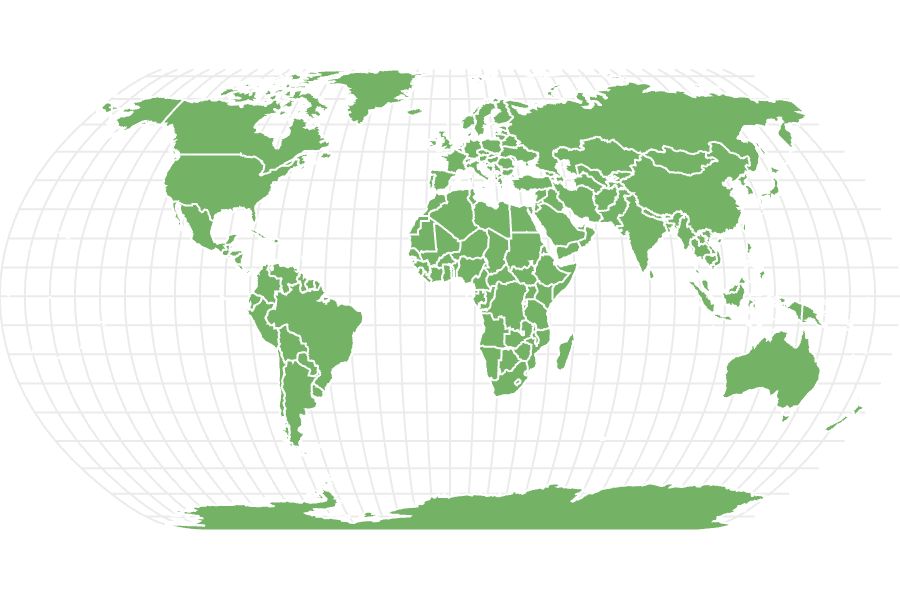Sea Turtle
The great migratory sea turtle roams the world’s open oceans, supremely well-adapted for an aquatic lifestyle.
Advertisement
Sea Turtle Scientific Classification
Read our Complete Guide to Classification of Animals.
Sea Turtle Conservation Status
Sea Turtle Facts
- Main Prey
- Fish, Crabs, Seaweed, Jellyfish
- Fun Fact
- The great migratory sea turtle roams the world’s open oceans, supremely well-adapted for an aquatic lifestyle.
- Habitat
- Tropical coastal waters and beaches
- Diet
- Omnivore
- Average Litter Size
- 100
View all of the Sea Turtle images!
The great migratory sea turtle roams the world’s open oceans, supremely well-adapted for an aquatic lifestyle.
From the first moment it hatches, the life of the sea turtle is a constant struggle for survival. Even if it survives the formidable odds on its journey to the sea, it must then navigate a treacherous world of predators, pollution, and human activity. Despite conservationists’ efforts to bolster numbers, the sea turtle is in danger. It will require a worldwide international conservation effort to save this creature.
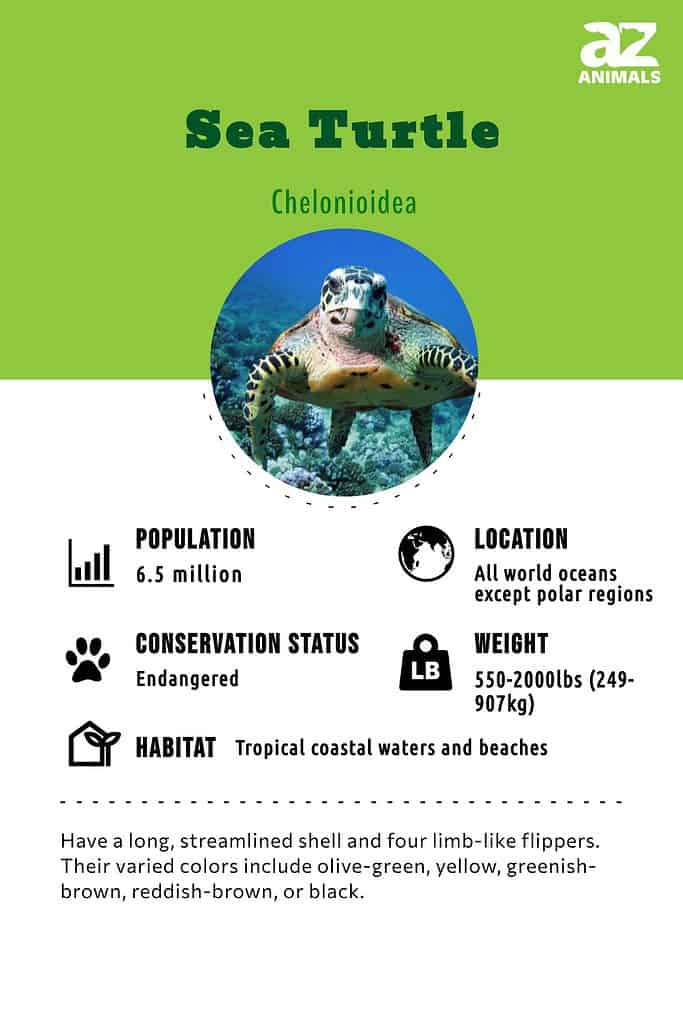
5 Incredible Sea Turtle Facts!
- Sea turtles lack the ability to withdraw inside of their shells when they are threatened.
- To navigate the world’s oceans, sea turtles possess the ability to sense the planet’s magnetic field.
- Sea turtles first evolved in the Late Jurassic Period some 150 million years ago, but the evidence suggests that modern sea turtles have descended from a more recent lineage, probably dating back around 110 million years. Leatherback turtles lived at the same time as the dinosaurs and have changed only modestly since then.
- One of the more amazing facts is that the leatherback sea turtle can dive up to a depth of 4,000 feet. This is deeper than any other mammal or reptile in the world.
- Sea turtles can reach incredible sizes. The largest sea turtle ever recorded was a loggerhead that weighed 2,019 pounds! Prehistoric sea turtles were even larger, with the ancient genus Archelon reaching 4,900 pounds.
You can check out more incredible facts about sea turtles.
Scientific Name
The sea turtle is a recognized taxonomical group with two living families. The family of Dermochelyidae, whose scientific name derives from Ancient Greek words meaning skin (derma) and the tortoise (khelus), only include the leatherback sea turtle. The family of Cheloniidae, whose scientific name simply derives from khelone (turtle), has six different species: the loggerhead, Kemp’s ridley, green, flatback, olive ridley, and hawksbill sea turtles. The primary difference between them lies in the composition of their shell. Both families belong to the order Testudines, which includes all known turtles, within the phylum of Chordata.
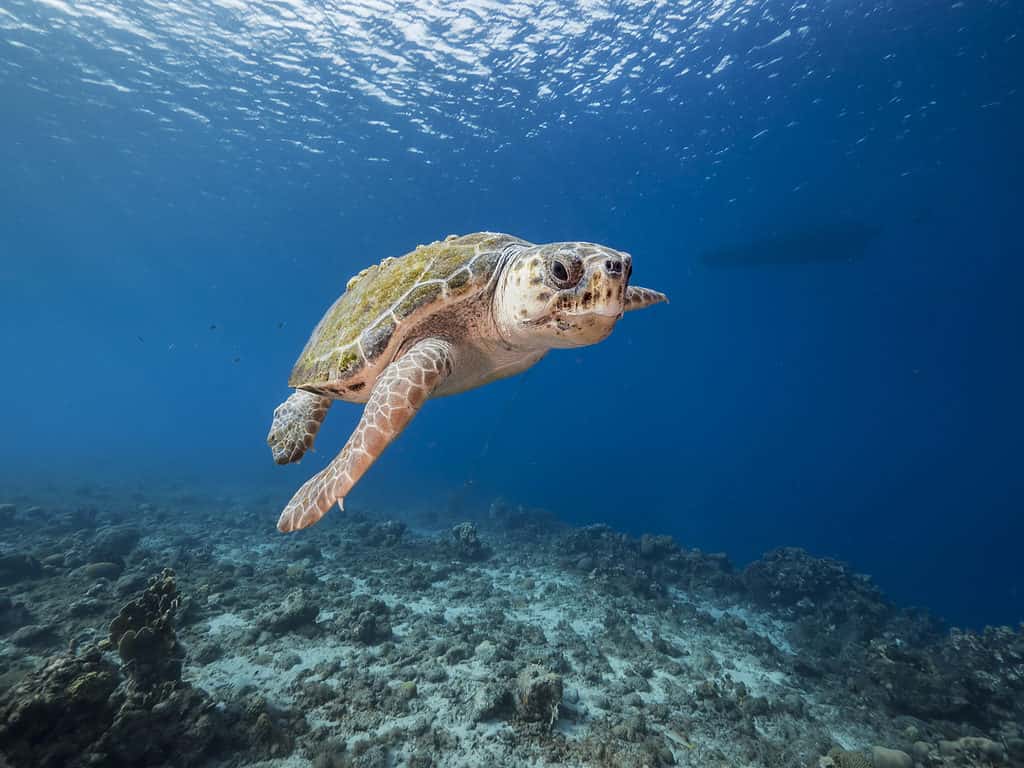
Both families of sea turtles belong to the order of Testudines, which includes all known turtles, within the phylum of Chordata.
©iStock.com/naturepics_li
Evolution
Sea turtles are descended from ancestors that date back as far as 230 million years. The fossil remains of the ancient species “Odontochelys semitestacea” date back to the Triassic period. Sea turtles evolved from freshwater and land turtles, and survived the last ice age, when many other animals became extinct.
Other fossils that date back 75 million years belong to the species Archelon Ischyros, an enormous reptile estimated to be 5 meters long and weigh 4,850lbs. It most closely resembles the leatherback turtle.
Types of Sea Turtles
There are two families of sea turtles, Cheloniidae and Dermochelyidae, which contain seven species, described below:
- Green Sea Turtle (Chelonia mydas) – One of the largest species, it inhabits tropical and subtropical waters, is migratory, and is a herbivore.
- Loggerhead Sea Turtle (Caretta caretta) – Primarily carnivorous species with very large head. It feeds mostly on shellfish.
- Kemp’s Ridley Sea Turtle (Lepidochelys kempii) – It’s the rarest and most vulnerable species of sea turtles in the world. They are mostly found in the Gulf of Mexico and named after named after Richard M. Kemp, the man who first submitted the species for identification in 1906.
- Olive Ridley Sea Turtle (Lepidochelys olivacea)– It’s olive green in color with a heart-shaped shell, and the most common of all sea turtle species. It’s found worldwide but listed as endangered.
- Hawksbill Sea Turtle (Eretmochelys imbricata) – Listed critically endangered. They have a unique beak-like mouth resembling a hawk’s for finding food in cracks and crevices. Diet mainly consists of sponges.
- Flatback Sea Turtle (Natator depressus) – Native to the beaches and coastal waters of the Australian continental shelf. Its shell is very flat with no ridges.
- Leatherback Sea Turtle (Dermochelys coriacea) – The largest turtle in the world, it lacks a shell and has tough, rubbery skin. Listed as endangered.
Appearance
In order to cope with the harsh life at sea, this turtle has evolved several unique adaptations, including a streamlined body to reduce friction and drag, flippers that allow it to navigate in the water, and rough projections in the throat to prevent food from slipping back up into the mouth. The most prominent feature, the shell, is composed of tough scales known as scutes that offer protection against deadly predators. The leatherback is the only species with a softer shell made from thin rubbery skin and fortified by thousands of small bony plates. Regardless of species, the shells consist of two major parts: the upper carapace and a lower section called a plastron. Each species has an identifiable number and arrangement of scales. However, it is not possible to identify the turtle’s age from its appearance alone.
The sea turtle comes in an enormous range of different sizes. The olive Ridley sea turtle, as the smallest species, can weigh as little as 50 pounds, while the gigantic leatherback sea turtle can reach almost 7 feet long and weigh nearly 2,000 pounds. Both males and females grow to approximately the same size; there are few physical differences between them.

leatherback sea turtle
©iStock.com/YasserBadr_Beenthere
Behavior
Sea turtles spend the vast majority of their lives in the ocean. Except when females come ashore to nest, they eat, rest, and copulate almost exclusively in the water. Although they do need to come up for air, sea turtles can remain submerged for up to seven hours at a time by slowing their heartbeat to conserve oxygen. They can go up to nine minutes in between heartbeats. However, stressful situations can cause the turtle to deplete its oxygen quickly, which can lead to drowning.
The sea turtle is not particularly fast (the top speed is only 22 mph), but it is always on the move. It completes an epic annual migration from feeding grounds to breeding areas and then back again. The length of the trip can vary by species, but most travel thousands of miles every year in large groups.
To navigate its underwater environment, the sea turtle has a good sense of smell and sight. And although it lacks visible ear flaps, it does have the ability to hear low-frequency sounds. The eyes also contain special glands that expel the excess salt from the body.
As a cold-blooded reptile, the turtle’s internal body temperature varies considerably in response to environmental conditions. The green sea turtle is the only species known to come up on the beach and soak in the sun outside of the breeding season. Most other species depend on the ambient temperature of the surrounding water to stay warm. However, unlike almost every other species of reptile, the leatherback sea turtle has the ability to maintain a consistent internal body temperature, which allows it to swim in colder waters. This also gives it a higher metabolism than other reptiles.
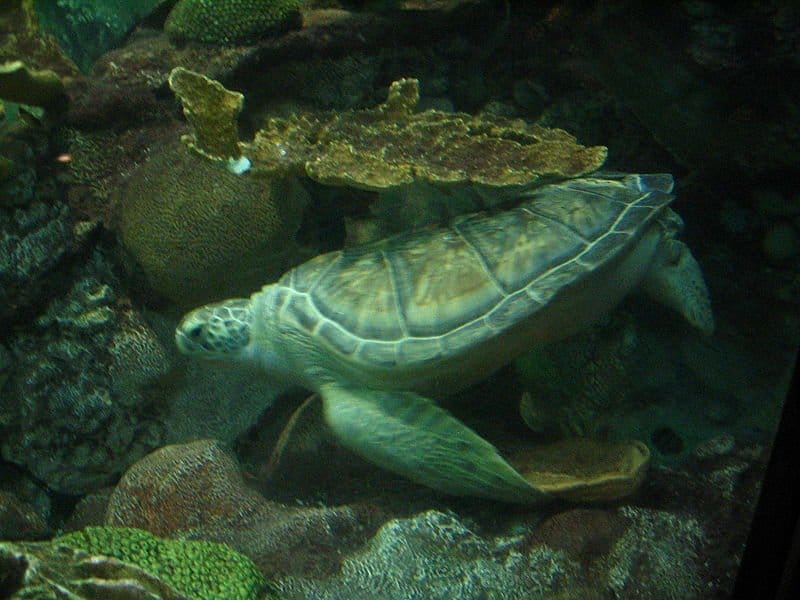
Sea turtles can remain submerged for up to seven hours at a time by slowing the heartbeat to conserve oxygen.
©Bryan Wittal – Public Domain
Habitat
These turtles inhabit almost every marine environment on the planet except for the most extreme polar regions, but it is most common around the tropics and subtropics. Two species in particular have a more localized distribution. The flatback sea turtle is found around the marine waters of Australia, while Kemp’s ridley turtle inhabits the Gulf of Mexico and the East Coast of the United States. Except for some populations of green sea turtles, the male spends his entire life at sea, while the female comes up on the beach to give birth in the breeding season.
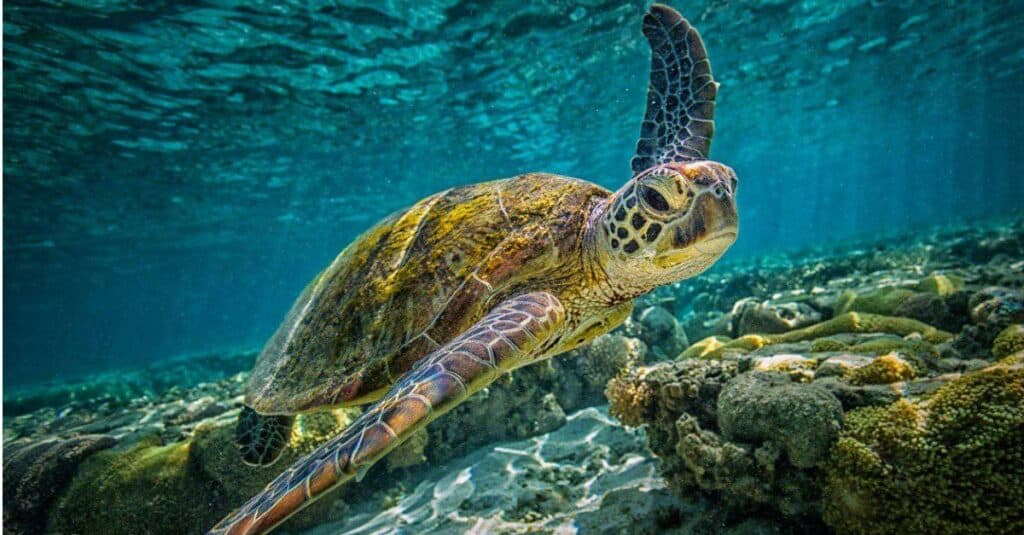
The most common habitat for sea turtles is marine environments around the tropics and subtropics.
©iStock.com/Greg Sullavan
Diet
These turtles have a remarkably diverse diet which can vary by species, location, and age. Some are specialized to feed only on certain foods, while others are generalists that feed on whatever they happen to find.
What does the sea turtle eat?
The loggerhead, olive ridley, hawksbill, and Kemp’s ridley sea turtles all share an omnivorous diet that consists of seaweed, seagrasses, sponges, mollusks, worms, fish, and much more. Most species have a sharp beak and mouth that’s specially adapted for reaching into the narrow crevices of coral reefs and extracting food. The leatherback turtle is slightly different since it tends to specialize in jellyfish. As a result, it has evolved immunity to the jellyfish’s sharp sting. The green turtle starts life as an omnivorous species, feasting on jellyfish and invertebrates, and then becomes a pure herbivore as an adult. With a serrated mouth, it feeds on a selection of seagrasses and algae, which give its body (though not the shell) a prominent green color.
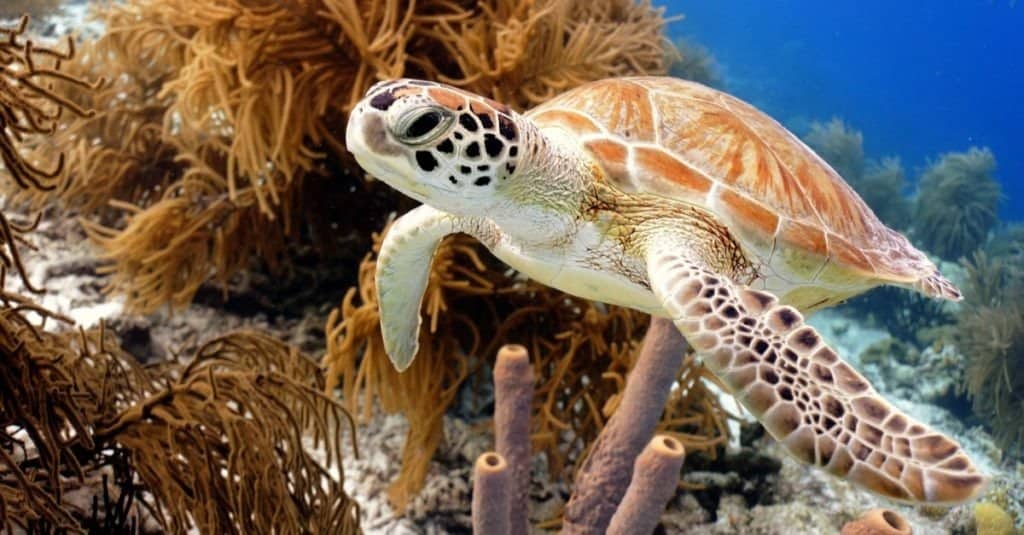
Most sea turtles feed on seaweed, seagrasses, sponges, mollusks, worms, fish, and more.
©Isabelle Kuehn/Shutterstock.com
Predators and Threats
Life for a sea turtle is filled with many dangers and threats, not all of which come directly from predators. Coastal development, habitat loss, and pollution have all limited the turtle’s natural range, while deaths from human activity, either due to intentional hunting or bycatch, are still prolific. Climate change is also a threat, though not just in the way you might expect. Because the surrounding ambient temperature determines the sex of the offspring, climate change is also tilting the sex ratio in favor of females.
What eats the sea turtle?
An adult turtle only has a few predators in the wild, including sharks, crocodiles, and in its nesting phase, large land mammals like jaguars. A newly born baby turtle has much to fear from raccoons, foxes, seabirds, and other predators on its journey back to the sea. But the water offers no respite either, since it may be preyed upon by seabirds, fish, and larger sea turtles.
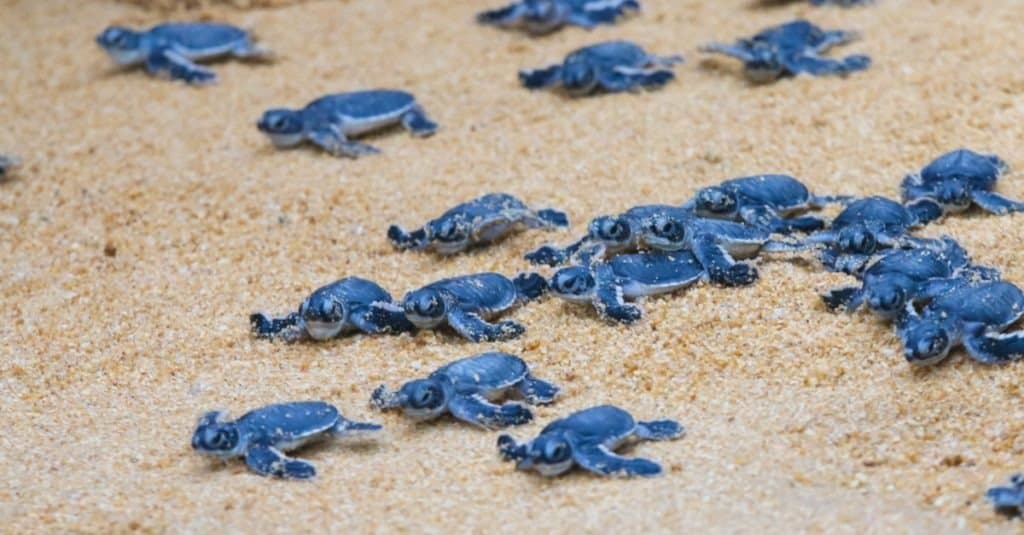
Baby sea turtles are preyed on by seabirds, raccoons, foxes, and other predators as they try to make their way to the ocean.
©zulkamalober/Shutterstock.com
Reproduction, Babies, and Lifespan
These turtles mate in the open ocean at some point in the breeding season. Once she’s impregnated, the female comes to the shore and then digs a hole in the sand to lay about 65 to 180 eggs per nest. Each nest is laid about two weeks apart over the course of several months. In total, this can result in two to eight clutches of eggs per breeding season. One of the more unusual facts is that the temperature of the surrounding environment determines the sex of the turtle. As temperatures climb, more females are produced.
Most turtles nest at night. Only Kemp’s Ridley turtles nest during the day. The eggs take about 60 days to hatch, during which time they receive no explicit protection from the mother. As the hatchlings emerge from the eggs, they begin the long, dangerous journey back to the sea. At this stage, many baby turtles fall victim to birds, mammals, and other voracious predators. Coastal lights might also cause the turtle to head in the wrong direction.
Once it reaches the sea, the baby turtle probably spends the early part of its life floating among giant beds of weeds or grasses, feeding and growing. After achieving the size of about a dinner plate, it moves to the more traditional feeding grounds. These turtles take an exceptionally long time to develop. They don’t reach sexual maturity until at least 15 years of age, sometimes much more. Depending on the species, the lifespan is usually somewhere between 50 and 100 years, but most young don’t survive the first few years of life.
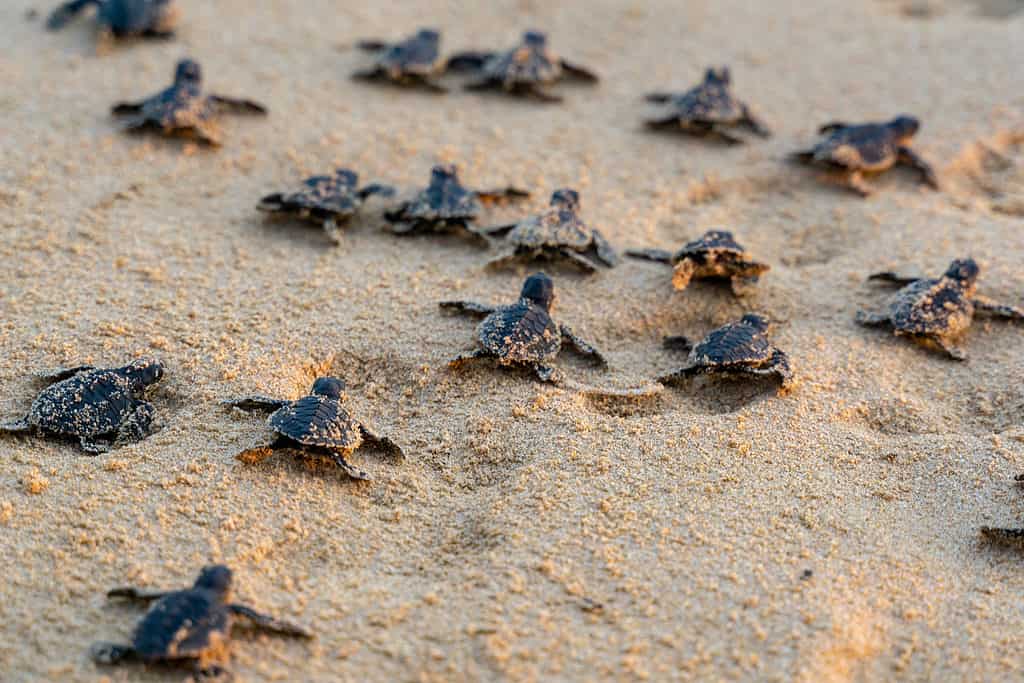
As sea turtle hatchlings emerge from their eggs, they begin the long, dangerous journey back to the sea.
©Julian Wiskemann/Shutterstock.com
Population
According to the IUCN Red List, three species are classified as endangered or critically endangered: the hawksbill turtle (which has more than 8,000 nesting females), Kemp’s ridley turtle (which has about 22,000 mature individuals), and the green turtle. Three more species are classified as vulnerable: the olive ridley turtle (with up to 800,000 nesting females), the leatherback turtle (which may have 30,000 to 100,000 mature individuals), and the loggerhead turtle. The flatback sea turtle is data deficient and not classified properly.
Learn more about the most endangered species in the world here.
Because there are so many threats, most conservancy efforts take a multi-pronged approach: reducing the incidence of hunting and poaching, altering fishing methods to end bycatch, restoring the natural habitat of the beach, minimizing the amount of trash and pollution in the marine environment, and mitigating the worst effects of climate change. According to the World Wildlife Fund, fishers can reduce bycatch by 60% to 70% alone just by putting lights in their gill nets to deter turtles. Circle hooks also seem to be an effective means to reduce bycatch. But it will take many people working on multiple fronts to improve conservancy efforts.
Sea Turtles in the Zoo
It may be an uncommon exhibit, but these turtles can be found in specialized aquariums across the country. The Houston Zoo rescues and rehabilitates injured or distressed sea turtles at its Kipp Aquarium, while the Columbus Zoo keeps a hawksbill sea turtle at its shores and aquarium section. The National Aquarium in Baltimore was once home to a fan favorite three-flippered green sea turtle named Calypso, who passed away in February of 2020.
View all 293 animals that start with SSea Turtle FAQs (Frequently Asked Questions)
Are Sea Turtles herbivores, carnivores, or omnivores?
Sea Turtles are Omnivores, meaning they eat both plants and other animals.
What Kingdom do Sea Turtles belong to?
Sea Turtles belong to the Kingdom Animalia.
What class do Sea Turtles belong to?
Sea Turtles belong to the class Reptilia.
What phylum to Sea Turtles belong to?
Sea Turtles belong to the phylum Chordata.
What family do Sea Turtles belong to?
Sea Turtles belong to the family Chelonioidea.
What order do Sea Turtles belong to?
Sea Turtles belong to the order Testudines.
What type of covering do Sea Turtles have?
Sea Turtles are covered in scales.
In what type of habitat do Sea Turtles live?
Sea Turtles live in tropical coastal waters and beaches.
What is the main prey for Sea Turtles?
Sea Turtles eat fish, crabs, seaweed, and jellyfish.
What are some predators of Sea Turtles?
Predators of Sea Turtles include humans, sharks, and killer whales.
How many babies do Sea Turtles have?
The average number of babies a Sea Turtle has is 100.
What is an interesting fact about Sea Turtles?
Sea Turtles always return to the same beach to lay eggs!
What is the lifespan of a Sea Turtle?
Sea Turtles can live for 60 to 80 years.
Why are sea turtles endangered?
The sea turtle faces many simultaneous threats in its native habitat, including predators, climate change, pollution, hunting, accidental bycatch, and coastal development. These factors have conspired to dramatically reduce the number of sea turtles in the wild.
What do sea turtles eat?
The diet varies by species, but the turtle’s common foods include jellyfish, seagrasses, mollusks, sponges, worms, and fish. Some populations specialize on only a single type of food, while others eat indiscriminately.
How long can a sea turtle hold its breath?
Under ideal conditions, the sea turtle can hold its breath for up to seven hours. However, short-term stress can use up available oxygen supply.
How long does a sea turtle live?
Some sea turtles have about the same lifespan as a human. It is thought that some species can even live up to 100 years of age.
How many eggs does a sea turtle lay?
A female sea turtle will lay approximately 65 to 180 eggs per nest. She can produce up to eight nests per breeding season
How fast is a Sea Turtle?
A Sea Turtle can travel at speeds of up to 2.4 miles per hour.
How do Sea Turtles have babies?
Sea Turtles lay eggs.
What are the differences between sea turtles and tortoises?
The main differences between sea turtles and tortoises are that sea turtles are aquatic, have streamlined shells, and have physical adaptions for life in the water. Tortoises are terrestrial, have domed shells, and are suited to life on land.
Read about other differences here!
What are the key differences between green sea turtles and leatherbacks?
The key differences between green sea turtles and leatherbacks are shell, size, appearance, distribution, diet, and conservation status.
Thank you for reading! Have some feedback for us? Contact the AZ Animals editorial team.
Sources
- National Geographic, Available here: https://www.nationalgeographic.com/animals/reptiles/group/sea-turtles/
- NOAA Fisheries, Available here: https://www.fisheries.noaa.gov/feature-story/10-tremendous-turtle-facts
- Sea Turtle Conservancy, Available here: https://conserveturtles.org/information-about-sea-turtles-an-introduction/
- Smithsonian, Available here: https://ocean.si.edu/ocean-life/reptiles/sea-turtles
- WWF, Available here: https://www.worldwildlife.org/species/sea-turtle

